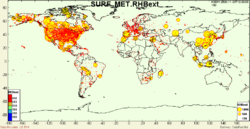Difference between revisions of "SURF MET"
| Line 6: | Line 6: | ||
|SampleMethod=Point | |SampleMethod=Point | ||
|DataType=POINT | |DataType=POINT | ||
| − | | | + | |Periodicity=HOUR |
|TimePeriod=REALTIME | |TimePeriod=REALTIME | ||
| − | |||
| − | |||
| − | |||
|ProviderAbbr=PSWC | |ProviderAbbr=PSWC | ||
|ProviderURL=http://vortex.plymouth.edu/ | |ProviderURL=http://vortex.plymouth.edu/ | ||
|DataAccessURL=http://vortex.plymouth.edu/ | |DataAccessURL=http://vortex.plymouth.edu/ | ||
|CitationURL=http://vortex.plymouth.edu/ | |CitationURL=http://vortex.plymouth.edu/ | ||
| + | |GoogleEarthURL=http://capita.wustl.edu/CAPITA/capitareports/070722_GEOSS_Demo_Barcelona/GoogleEarth/SURF_MET.kml | ||
| + | |keyuse=Exceptional Event | ||
| + | |GeoRange=GLOB | ||
| + | |Parameters=T,TD, RH, DIR, SPD, GST, ALT, SLP, VIS, CIL, COV, WX, Bext, FBext, RHBext | ||
}} | }} | ||
| − | |||
== <center> User-Contributioned Resources. See also [[Talk:{{PAGENAMEE}}|discussion]] page. Help on [[Help:Editing| Edit]]. </center>== | == <center> User-Contributioned Resources. See also [[Talk:{{PAGENAMEE}}|discussion]] page. Help on [[Help:Editing| Edit]]. </center>== | ||
===Dataset Description === | ===Dataset Description === | ||
Revision as of 09:01, April 18, 2013
SURF_MET - Global Surface Meteorology Monitoring Network
 |
Description: SURF_MET is a dataset gathered by WMO. Currently, there are about 10,000+ SURF_MET stations worldwide. Data delivered through Plymoth State Weather Center. Parameters: T,TD, RH, DIR, SPD, GST, ALT, SLP, VIS, CIL, COV, WX, Bext, FBext, RHBext |
- Browse Fields
- RDF for SURF_MET <- Should be a property
- What Links here on ESIP wiki
- 400px
User-Contributioned Resources. See also discussion page. Help on Edit.
Dataset Description
SURF_MET is a dataset from routine monitoring of surface weather parameters. Currently, there are about 1,200 SURF_MET stations over the US recording weather data every minute. The SURF_MET dataset is archived at the Plymouth State Weather Center and accessible to DataFed through a web-based interface. The SURF_MET parameters include relative humidity, wind direction and speed, as well as the light scattering coefficient, Bext, obtained by the ASOS forward scattering visibility sensor (actually Bscat). The 1,200 station visibility data are particularly useful for delineating the spatial-temporal extent of hazy air-masses from dust, smoke, or anthropogenic haze events. A major limitation of this SURF_MET visibility data is the truncation of high visibility at ten miles which precludes the detection of haze events with greater than ten mile visibility. In this Exceptional Event Analysis report we only used the surface wind vectors from the SURF_MET dataset.
Related Links
- Google Scholar Search
Failed to load RSS feed from http://del.icio.us/rss/tag/googlescholar+surf_met+datafed: Error parsing XML for RSS
